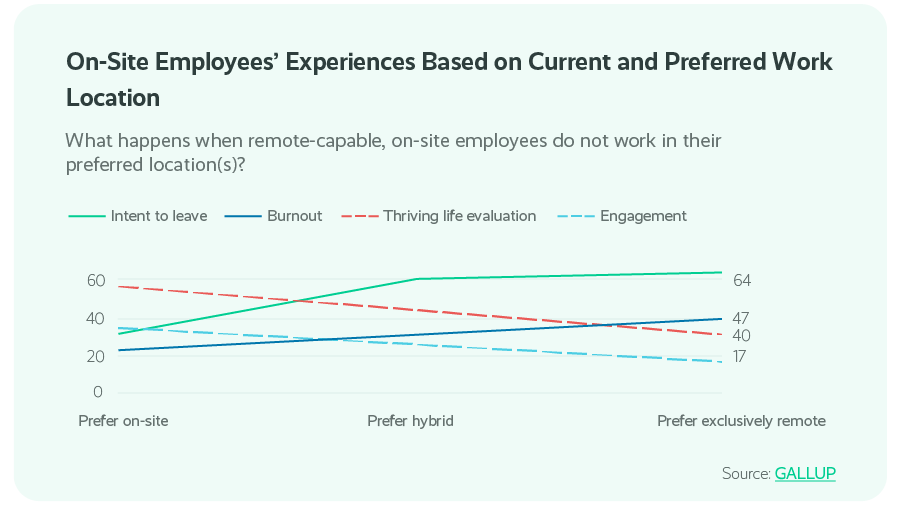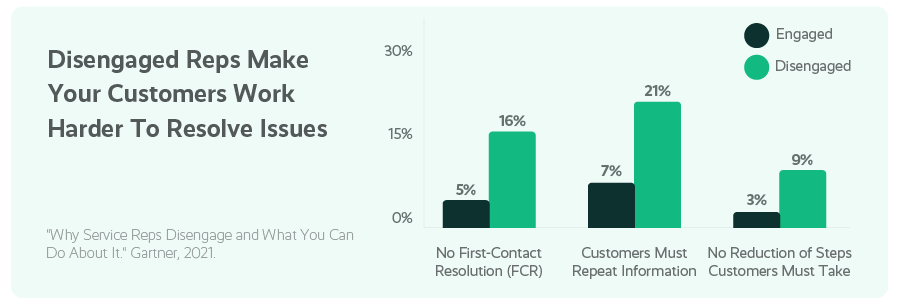Make Every Agent Your Best Agent With WFM — Even Remotely
Agent performance optimization isn’t a new challenge for CX leaders. Post-pandemic, distributed workforces operating in remote and hybrid environments, though, have made getting the most out of your teams a lot more complicated—and important.
Add uncertain economic conditions to the mix, and the need for maximum employee output is acute.

The most successful contact centers strike a delicate balance between controlling operational costs and delivering the highest levels of customer satisfaction. At the heart of that balance is employee performance optimization.
How Do You Strike the Right Balance For Success?
Getting performance optimization right takes (effectively) managing a growing—sometimes seemingly endless—number of considerations, including :
- Customer demand
- Contact volumes
- Agent availability
- Agent preferences
- Agent skill sets
- Agent workloads
- Channel requirements
- Employee schedules
- Scheduling preferences
And there are plenty of nuances (Think: skills-based routing, intraday management, fully utilizing multi-skilled agents, accurate forecasting). All the internal processes and moving parts are a lot to juggle, even for the most experienced workforce managers.
In today’s increasingly common remote and hybrid environments, workforce managers accustomed to being on the support center floor with their teams can feel like they are at a new, mounting disadvantage. As a result, getting to optimal productivity can seem daunting—maybe even unachievable.
The good news, though, is that when you start with the right approach and informed perspective, then arm yourself with powerful workforce optimization tools and other contact center solutions, success is in reach.
Why Support Center Agents Want To Work Remotely— And Why You Should Let Them
Remote and hybrid work are no longer unrealistic expectations for customer support center agents. And these new work situations don’t have to be detrimental to the customer experiences your team delivers.
In a 2022 Playvox study of CX centers in the United States and Canada, nearly 60% reported using hybrid work models, while almost 40% of contact center operations were entirely remote. Elsewhere around the world, the International Labor Organization reports that 23 million people in Latin America and the Caribbean transitioned to remote work at the beginning of the pandemic.
While some customer service centers are transitioning back to the office, support center agents continue to want the option to work remotely. Agents in our survey considered it the top motivator when choosing work or staying with a customer service organization. In our research, 56% of respondents said they would consider leaving a job if they couldn’t continue to work from home.
Often, customer service center managers assume bringing agents back together under one roof would be a quick and easy employee productivity booster, while improving customer experiences and driving down operational costs. However, Gartner research paints a different picture.
According to the Gartner, remote workers trust their organizations more and are more productive employees. That makes remote work a clear winner for employee efficiency and employee satisfaction. On the other hand, bringing back agents who don’t want to be in the office can have measurable negative effects on operational efficiency, based on research. Gallup found that when employees who want to work remotely aren’t allowed to, customer service centers experience higher rates of employee burnout. That ultimately leads to higher employee turnover rates and a far less productive workforce—and customer service center.

Remote work doesn’t have to be a minefield of potential issues for contact center supervisors or for a brand’s CX. By tracking key metrics and using smart technology, like sophisticated workforce management software with powerful artificial intelligence (AI) features and insightful contact center analytics, you can keep a close eye on your remote agents’ success and overall employee productivity—without becoming Big Brother in the process.
Related Article: 5 Ways Contact Center Managers Are Adapting to Remote Work
Essential KPIs To Track When You’re Managing (And Optimizing) Remote Agents
No matter where your team is working, it’s critical to maintain key performance indicators (KPI) and business metrics, including CSAT, NPS, productivity rates (sometimes measured as occupancy), and adherence. Monitoring these key metrics is essential to effective employee performance management and maintaining proper standards for your entire team, regardless of where individuals work. When teams are remote, the right software solutions are critical to contact center success. Today, leading CX centers rely on AI-infused quality management and workforce management technologies to provide superior customer experiences, improve efficiency, and reduce costs.

The Playvox study found 68% of agents work remotely 31-40 hours per week and most managers (64%) work remotely five or more days per week. Technologies like quality management or workforce management tools offer the constant support and feedback needed to sufficiently resolve customer issues and deliver the intended customer service experience. It also keeps your agents happier.
Sophisticated contact center workforce management tools and quality management solutions help managers “walk the customer service center floor” virtually, staying engaged with their teams, ensuring positive employee experience, and driving exceptional experiences with all customer interactions, at every customer touchpoint.
Highly sophisticated workforce management tools like Playvox deliver speed and efficiency to the scheduling process through features to help manage:
- Planned vs actual staffing—by location and work type—in real time, powered by AI
- Contact center schedules through accurate forecasting
- Support of shift swaps and time-off request for better employee engagement
- Agent access to key metrics
Choose a workforce management with a simple, interactive performance dashboard that covers all your KPIs so you can master planning and performance. The most sophisticated performance dashboards incorporate AI and include shrinkage, adherence monitoring, work streams, occupancy, service levels, and forecast accuracy.
With these advanced contact center workforce management software features, workforce managers, agents, and customers, all win. Your customer support center will see sudden spikes in performance indicators.
Related Article: How to Manage a Remote Contact Center Now: 6 Best Practices
Agent Engagement Is Good For Business
Diagnosing opportunities for improvement in customer interactions when you are on the customer service center floor with your agents every day is straightforward. But for contact center supervisors managing from a distance, coaching remote agents and recognizing them when they do well is a much bigger, more complicated challenge.
The path to optimization is easier when agents have visibility into the metrics that are most important to the success of the overall business. This level of insight helps employees understand how their own performance directly impacts business success. It motivates them to stay engaged. Having a solution that automatically surfaces the areas that need coaching also will help virtual leaders efficiently coach remote workers and make a fast impact on customer experiences.
Engaged agents are good for business. Consistently high engagement decreases attrition rates and turnover rates, and it increases training costs.
Keeping Remote Agents Engaged Through A Culture of Recognition
Once agents understand what customer experience metrics are critical to the business, it’s important to quickly recognize an employee’s positive achievements. This keeps them engaged, which keeps them motivated to provide a great customer experience and adhere to internal processes.
On the other hand, when agents become disengaged, it can do real damage to the customer experience that support organizations work hard to build. Customer experience is at the foundation of a healthy business—in any economic climate, but especially in uncertain times like these.
Gartner found that when agents are disengaged, customer service measurably diminishes in these very specific ways:
- Agents are less the likely to resolve issues on first contact, across communication channels
- Customers must repeat information more often
- It requires more steps to find issue resolution, leading to higher average handle times
When customer service agents are engaged, all these areas improve, resulting in much better overall customer experience.

Engaged agents become more skilled agents and are easier to manage. They are more invested in their work and meeting the performance goals you set just for them when they can see, track, and understand all key metrics. They handle customer requests better and answer customer questions quickly and more effectively, driving improvements in customer satisfaction scores.
Recognizing achievements also helps remove the anxiety some agents have around quality management. Quality management is not just a tool for finding out what’s wrong, it’s a way to celebrate what’s going well. Quality management is an important workforce engagement tool.
For example, when you do find an issue to be fixed through quality management, aim to coach agents toward improvement rather than reprimanding. An automated solution that integrates with your quality management software to deliver targeted coaching will make it easier and faster for you to get agents the support they need.
Focusing on keeping agents engaged and motivated is far more productive and helps retain your team and reduce costs.
Related On-Demand Webinar: Coaching: Tips and Tricks to Make it Effective
Maintaining Quality Without Micromanaging
Occupation/productivity and adherence rates are valuable measures of success. Customers’ sky-high expectations —and your service level agreements with them—require delivery of timely and effective service.
Ensuring agents work on assigned tasks during their shifts is essential to providing the speedy interactions customers demand. But without the right solutions in a remote or hybrid environment, it’s impossible to tell if that’s happening. When you can’t be sure, you put your service levels—and your customer relationships—at risk. And that is simply not an option for organizations that want to stand out and thrive in economic uncertainty.
By effectively using key metrics, you can understand what’s happening in your support center remotely without micromanaging your team—a surefire way to decrease employee engagement. When you identify agents who are struggling with productivity, support and coach them to success.
A workforce management solution that allows real-time monitoring of agent adherence and productivity will help you identify opportunities for performance improvement.
Related Article: Capacity Planning Needs An Overhaul: 5 Tips For A Turnaround
Forecasting And Scheduling To Ensure Every Agent Shines
An accurate forecast of the volume of interactions by service channel is a definitive factor for capacity planning and scheduling the right number of agents in each channel. No company can operate efficiently and afford too many or too few resources. That’s why contact center analytics are so important.
Workforce management solutions (like Playfox WFM) use AI to take historical data and predict future needs with greater precision. For example, these features can calculate the optimal number of agents needed in each channel to provide the desired customer experience. In a remote environment, reporting tools are indispensable.
Spreadsheets, even with complex macros, can’t manage employee schedules against customer demand as efficiently as workforce management technology can. As a result, the benefits of AI-driven workforce management are exponential.
Related Article: How WFM Tools Create Success for Omnichannel Contact Centers
Let Technology Do The Heavy Lifting
Technology is your friend. Leverage it.
Workforce engagement management solutions, such as contact center workforce management and quality management, are strong allies for CX centers in facing the challenges created by remote work and customers’ rapid adoption of new digital support and service channels. Integrating your CRM and your workforce engagement management solution is essential to empowering your teams and providing five-star service.
Contact center workforce management solutions allow you to see what’s happening as if your entire team was on-site. These tools can break down silos and bring previously in-person internal processes to life remotely—giving every agent an opportunity to become your best agent.
Playvox Can Help You Make Every Agent Your Best Agent With Superior Contact Center Workforce Management
Learn more about making the most of your hybrid or remote team in our ebook The Contact Center Conflict: Remote Work vs. Return to the Office. In it, you’ll find out what agents want as remote employees and how to deliver it.
Contact us to learn more about Playvovox’s contact center workforce engagement management solutions and how we can help empower your agents and managers, regardless of where they work.







